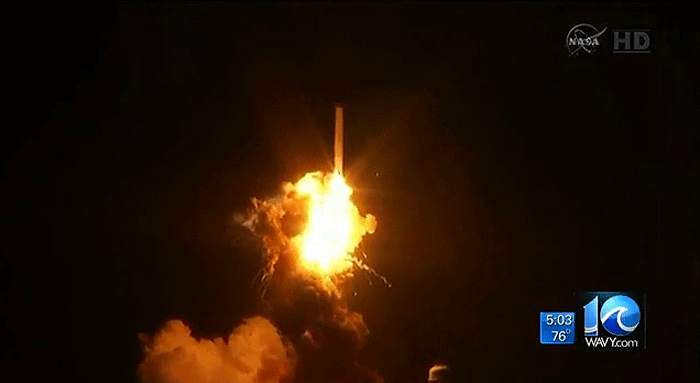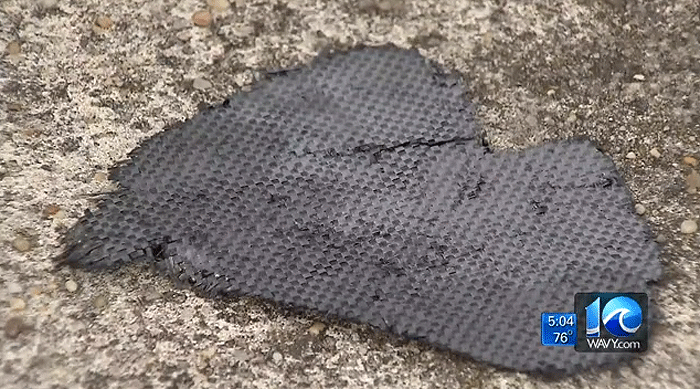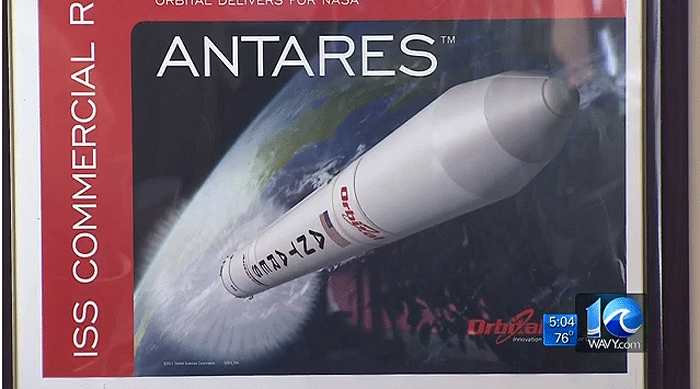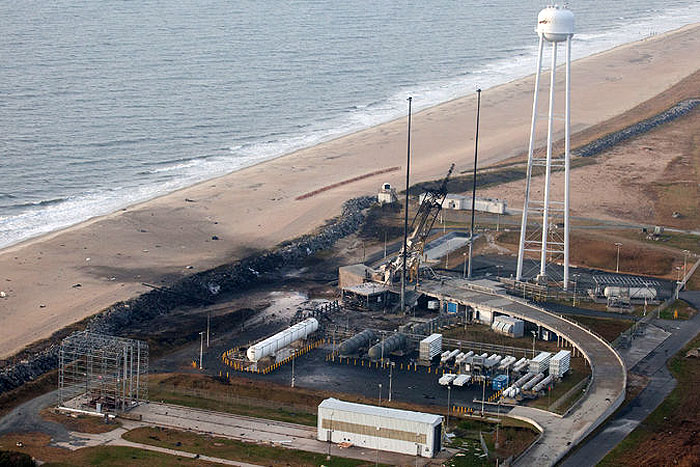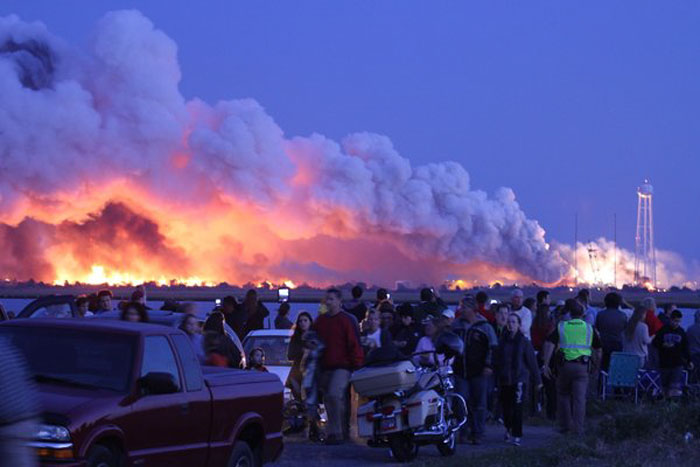30.10.2014
Frams: Fehlstart von Antares Orbital CRS3
.
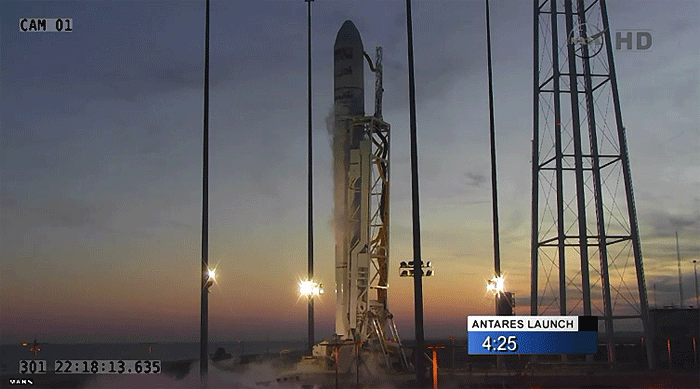
.
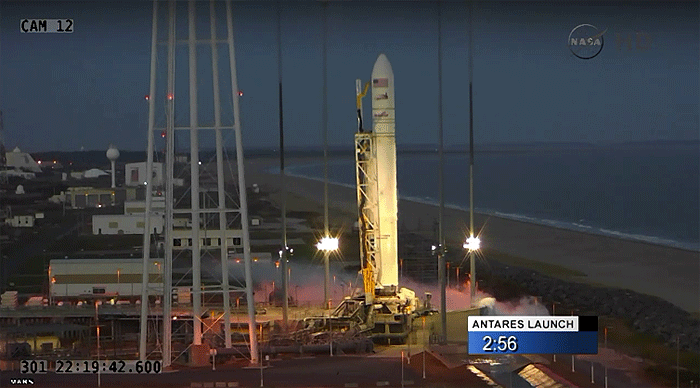
.
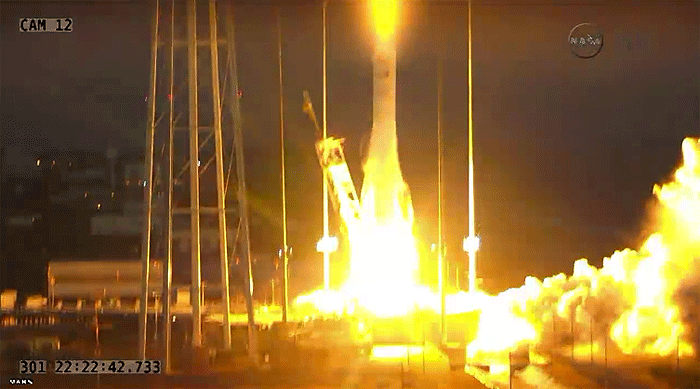
.
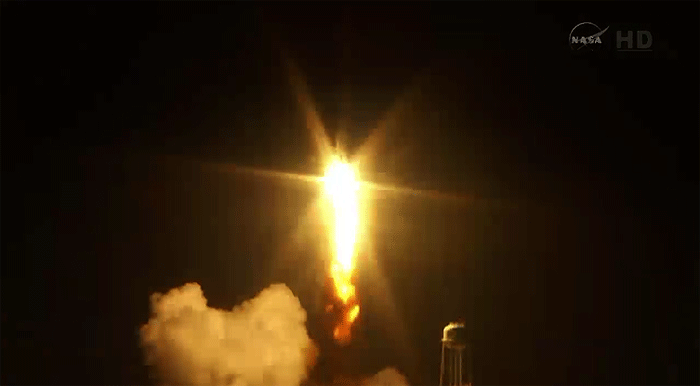
.
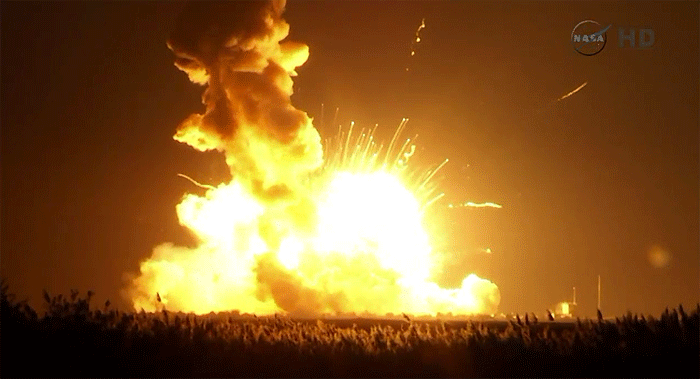
.
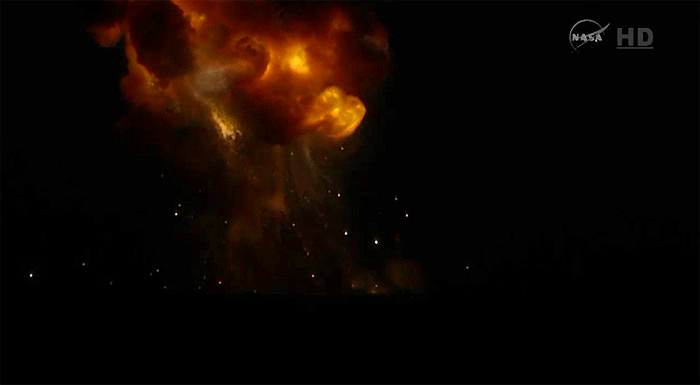
.
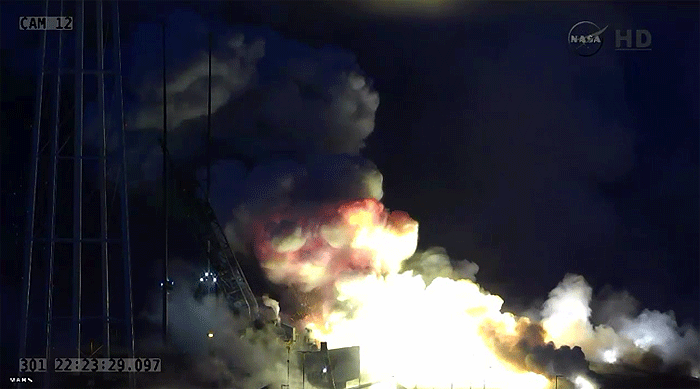
Quelle: NASA-TV
...
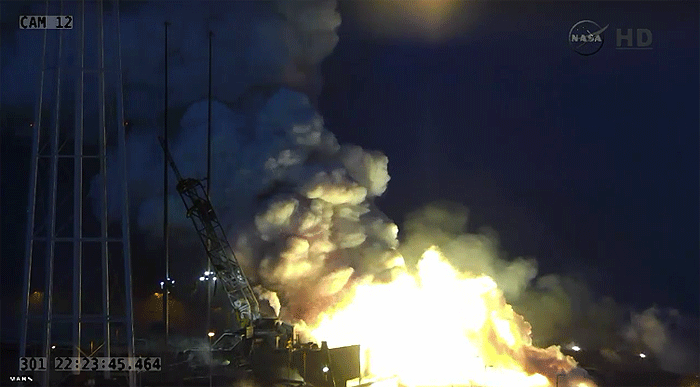
.
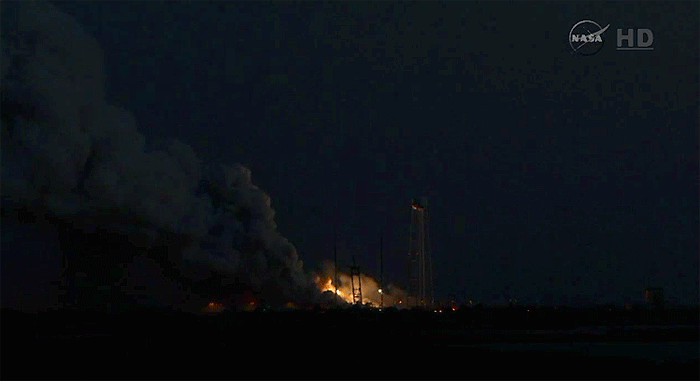
.

...
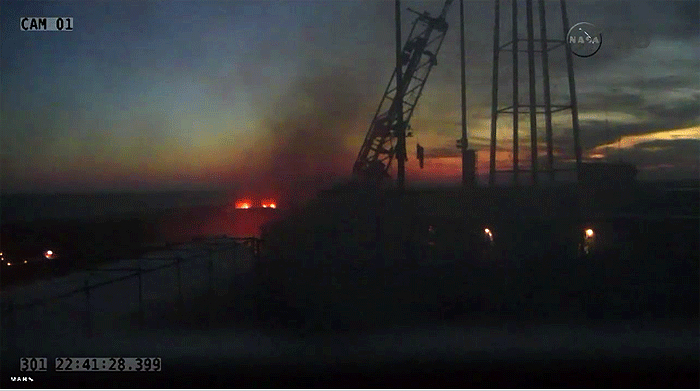
.
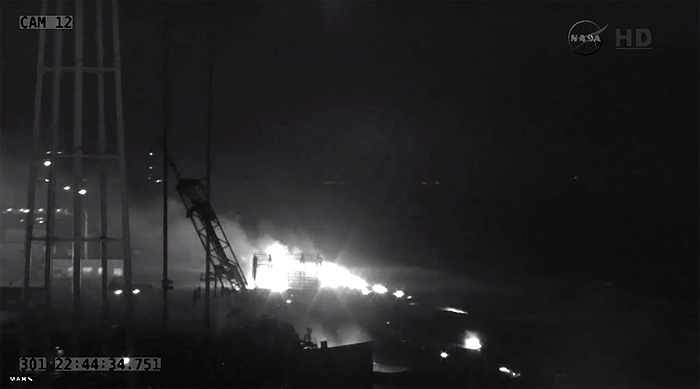
.

...
Private Spaceship Bound for Space Station Explodes on Launch
A private spaceship bound for the International Space Station exploded shortly after launch on Tuesday. Orbital Sciences' unmanned Cygnus spacecraft exploded as it blasted off atop an Antares rocket a few seconds after liftoff Tuesday evening from NASA's Wallops Flight Facility on Wallops Island, Virginia.
NASA Mission Control reported via its TV channel that no personnel were in the blast radius and no injuries have been reported. The launch was scheduled to take place at 6:22 Eastern time, but "suffered an accident" and exploded on the platform. It came after a "flawless countdown," NASA said, during which "the team was not tracking any issues."
The rocket launch was to be Orbital Sciences' third official cargo mission to the Space Station for NASA under a $1.9 billion contract, which calls for a total of eight delivery missions. The robotic Cygnus spacecraft — also built by Orbital — was filled with 5,000 pounds of food, water, experiments and other gear for the astronauts currently living aboard the space station.
An accident investigation team is being formed from NASA and Orbital personnel.
Quelle: NBC
.
Update: 29.10.2014
.
NASA, Orbital Begin Antares Loss Investigation
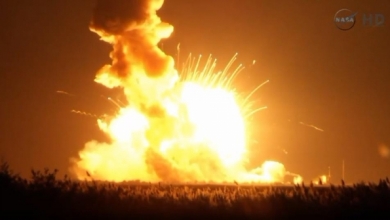
LOS ANGELES - NASA has secured the area around the Wallops Flight Facility in Virginia as the investigation begins into why an Orbital Sciences Antares rocket blew up just seconds after liftoff on its way to deliver a Cygnus cargo spacecraft to the International Space Station (ISS).
The vehicle, the first stage of which is powered by two refurbished AJ-26 rocket engines, suffered a “catastrophic anomaly shortly after liftoff,” the agency says. The mission was to have been the third Orbital resupply flight to the ISS, carrying 5,000 lb. of NASA cargo, and had been delayed from a previous attempt on Oct. 27 because of a boat straying into the range safety zone southwest of the launch pad.
“The ascent stopped. There was some disassembly of the first stage, it looked like, and then it fell to earth. We don’t have any early indications of what exactly might have failed,” Orbital Executive Vice President Frank Culbertson said at a press conference shortly after the mishap. Although investigators are keeping their options open, a prime suspect is expected to be a potential failure mechanism involving the AJ-26, a liquid oxygen/kerosene-powered engine originally developed for the Russian space program as the NK-33. An AJ-26 slated to power an Antares on a mission to the ISS in 2015 experienced a failure during a hot-fire test at NASA’s Stennis Space Center in Mississippi on May 22.
“We didn’t see any anomalies or anything that would indicate there were problems with the engine," Culbertson said. "We don’t know whether the engine was involved at all or not. These were extensively tested, are very robust and rugged, and go through extensive testing at Stennis before they are installed on the rocket. These went through normal acceptance and pressure testing.” Orbital announced earlier this month it had selected a new main engine for the Antares, but has not yet revealed the supplier or the engine itself.
The failure visibly occurred around 10 sec. after liftoff at 6:22 pm EDT, and range safety officials triggered the vehicle’s flight termination system about 20 sec. after liftoff as the rocket was descending. The resulting explosions took place very close to, and partially above, the launch facility. Images of the site show burning debris littering the pad area and the adjacent beach on the Atlantic coast. NASA says the range confirms launch officials are continuing to secure the area, and adds that all personnel are accounted for and there have been no injuries.
Quelle: Aviation Week
-
NASA Statement Regarding Oct. 28 Orbital Sciences Corp. Launch Mishap
The following statement is from William Gerstenmaier, Associate Administrator of NASA’s Human Exploration and Operations Directorate, regarding the mishap that occurred at Pad 0A of the Mid-Atlantic Regional Spaceport at NASA’s Wallops Flight Facility in Virginia during the attempted launch of Orbital Sciences Corp’s Antares rocket and Cygnus cargo spacecraft at 6:22 p.m. Tuesday, Oct. 28.
“While NASA is disappointed that Orbital Sciences' third contracted resupply mission to the International Space Station was not successful today, we will continue to move forward toward the next attempt once we fully understand today's mishap. The crew of the International Space Station is in no danger of running out of food or other critical supplies.
“Orbital has demonstrated extraordinary capabilities in its first two missions to the station earlier this year, and we know they can replicate that success. Launching rockets is an incredibly difficult undertaking, and we learn from each success and each setback. Today's launch attempt will not deter us from our work to expand our already successful capability to launch cargo from American shores to the International Space Station.”
Quelle: NASA
.
Update: 30.10.2014
.
Residents find scattered debris, broken glass after failed launch
A U.S. commercial rocket powered by a Soviet-built Russian rocket engine exploded seconds after liftoff early Wednesday morning Moscow time, adding fire to debates concerning the U.S. space industry's heavy use of Russian rocket engines.
While unfortunate, the incident does not threaten the International Space Station (ISS), which was hoping to receive supplies from the ill-fated rocket. The ISS crew has supplies to last until the middle of next year, and a Russian Progress cargo ship successfully lifted off from Kazakhstan's Baikonur Cosmodrome on Wednesday with goods for the station.
Regardless, the failure of the Antares rocket — which uses a Russian engine and Ukrainian components in the rocket's body — shines light on the deeply co-dependent nature of space flight after the Cold War.
As Dr. James Oberg, a former NASA engineer and expert on the Russian space program, told The Moscow Times by phone on Wednesday: "In the end, we are too mutually co-dependent to do anything but scream and shout and then take the money."
The NK-33
The story of the engine used in Wednesday's launch — the NK-33 — is a perfect illustration of this co-dependence. Originally built for the Soviet's massive N1 moon rocket, Russia's Kuznetsov design bureau dumped its stock of NK-33s on the market in the 1990s for purchase by Western aerospace firms.
The NK-33 Engine
Designer: Kuznetsov Design Bureau
Upgraded: Early 1970s, originally built for the unused N1 moon rocket in the late 1960s.
Production Volume: While it is unclear how many were made, about 150 to 200 are reported to have survived destruction when the N1 program was canceled in 1974.
Cost: $1.1 million each under the original contract for the delivery of 36 engines to Aerojet in the mid-1990s.
Weight: 2,723 pounds (1,235 kilograms)
Length: 12 feet (3.7 meters)
Diameter: 6 feet, 7 inches (2 meters)
Fuel: Liquid oxygen and kerosene mixture
Thrust: 338,000 pounds of force (1,505 kilonewtons)
A testament to Soviet engineering prowess, the NK-33 today is purchased by U.S. middleman Aerojet-Rocketdyne in bulk from Kuznetsov for restoration under contract for Orbital Sciences another U.S. firm. Orbital Sciences then plugs them in to the first stage of its Antares rocket.
But the decision to use a 40-year-old rocket engine has not been without its critics. Shortly after the explosion on Wednesday, an excerpt from a 2012 interview in Wired magazine with Elon Musk, founder of U.S. space firm SpaceX, made the rounds on Twitter: "One of our competitors, Orbital Sciences, has a contract to resupply the International Space Station, and their rocket honestly sounds like the punch line to a joke. It uses Russian rocket engines that were built in the '60s. I don't mean their design is from the '60s. I mean they start with engines that were literally made in the '60s and, like, packed away in Siberia somewhere."
But according to Oberg, this misses the point.
"High-pressure liquid engines [like the NK-33] were really perfected back during the moon race," Oberg said. "The designs since then have been marginally improved but not enough to justify the fabrication [production] expenses." This makes buying existing engines extremely economical for private space companies worried about their bottom line.
Glory Days
The NK-33 was a child of the 1960s space race, a result of failed Soviet efforts to answer U.S. President John F. Kennedy's challenge in 1961 to land a man on the moon by 1970.
The Soviets were slow to rally a response. Only in 1964 did Soviet premier Nikita Khrushchev finally gave his ace in the hole — genius Ukrainian-born rocket designer Sergei Korolyov — the go-ahead to build a heavy-lifting rocket to eventually challenge NASA's Saturn V in the race to the moon.
But the program was troubled from inception. As with any large technological project, key design decisions and bureaucratic competition for lucrative contracts sparked serious internal power struggles between factions of Soviet space officials.
The most prominent internal struggle led to the creation of the NK-33. Korolyov had a long-standing dispute with another major player in the Soviet space industry — Valentin Glushko. The two had testified against the each other during Stalin's purges, resulting in both of them being thrown in the gulag.
Glushko and Korolyov tried to work together on the N1, but Glushko wanted to use a type of engine with poisonous fuel, something unacceptable to Korolyov. So, in an effort to find a designer that would remain loyal to his projects he had to look outside the space industry.
Nikolai Kuznetsov's design bureau, which had only ever built engines for aircraft and cruise missiles, stepped up to the task and produced the engines Korolyov needed for his massive rocket — first the NK-15, and later the NK-33.
Before the rocket even began testing in 1969, Korolyov died. Internal bleeding during an operation in 1966 took the rocket designer's life, and Soviet lunar aspirations went with him.
Without Korolyov to rally the disparate elements of the Soviet space-industrial complex, the N1 project was eventually torpedoed by Glushko and his political patrons in 1974, after the rocket had exploded on four consecutive launch attempts.
While Glushko would lead the Soviet space industry to several great accomplishments over the next 15 years, including its pioneering space station program and the Soviet space shuttle program, the Soviets would never land on the moon.
Korolyov's legacy lived on, however. His N1 was a huge rocket, using 30 of the NK-33 engines. Some 200 of the engines were built for the program, and after the N1 was scrapped no one was quite sure what to do with them.
Decades in Limbo
With the engines already built, the waning years of the Soviet empire saw numerous proposals to integrate the powerful NK-33s into existing and developing rocket designs. None of them came to fruition. The engines sat in storage.
"Evidently, the people who built these engines took very good care in mothballing them," Oberg said. "Russians use the word 'konservirovat' — which I always have fun translating into 'greasing', as they are referring to the process with [maintaining] weapons. Anyway, whoever did the onservirovat on these engines did a very good job."
When the Soviet Union collapsed and Soviet space firms were forced to improvise during the chaotic privatization process of the 1990s, they turned to Western markets and surprised aerospace companies with their high-quality hardware and relatively low prices.
Kuznetsov had hundreds of NK-33s sitting in storage. In the late 1990s, it went into partnership with Aerojet-Rocketdyne to refurbish the engines and sell them to commercial space upstarts in the U.S.
Lockheed Martin was interested in the engines for its Atlas V rocket, but in the end opted for another Russian engine — NPO Energomash's RD-180, which is still in production.
The engines waited in the U.S. for a new potential buyer until 2010, when Orbital Sciences bought 20 of the engines from Aerojet in 2010 for its Antares rocket, which was competing for a NASA contract to take over resupply launches for ISS from the retiring space shuttle fleet.
Back in Russia, there has been increasingly serious talk of restarting production of the NK-33 at the Kuznetsov factory in Samara, a city in central Russia. Russian media reports last year said Russian space officials were interested in resurrecting the engine for use in future Russian rockets.
The loss of the Antares rocket with a Russian engine on Wednesday is not likely to unravel U.S.-Russia commercial space cooperation. Both industries have become close over the past 20 years, engaging in a number of joint-ventures. Russian rockets are called upon frequently to launch Western commercial satellites, while the U.S. Air Force relies on another Russian rocket engine — the RD-180 — to power the Atlas V rocket for military launches.
Orbital will eventually have to find itself a new engine, as plans to restart production of the NK-33 have not materialized. Indeed, there appears to be no need for the engine in Russia or abroad, as the direction of the industry is changing to embrace cheaper and easier to produce technologies — philosophies enshrined in SpaceX's Falcon 9 rocket and Russia's new Angara.
"Perhaps the future of high efficiency Russian engines like the NK-33 is already behind us. It's not the type of approach that the vehicles now on the drawing boards and approaching the launch pad are using," Oberg explained.
Quelle: The Moscow Times
.
Update: 6.11.2014
.
Initial probe of unmanned rocket explosion points to engines, exec says
n initial investigation of last week's explosion of an unmanned rocket bound for the space station is pointing to a failure of the decades-old Russian engines used to launch it, Orbital Sciences Corp. executives said Wednesday.
As a result, Orbital will no longer use the rocket engines, which were built in the 1960s and 1970s during an unsuccessful attempt by the Soviet Union to take cosmonauts to the moon. The engines were later purchased by Aerojet Rocketdyne, refurbished and supplied to Orbital for NASA's cargo missions.
The Oct. 28 explosion of Orbital's Antares rocket caused no injuries, but it destroyed a capsule carrying more than two tons of supplies, equipment and experiments to the International Space Station. NASA officials said after the crash that the engines had passed all the required pre-launch tests.
But two of the reworked Soviet-era engines, known as the AJ-26, had exploded in two early ground tests, including one in May and another in 2011.
"Current evidence strongly suggests that one of the two AJ-26 main engines that powered Antares first stage failed about 15 seconds after ignition," David Thompson, Orbital's chairman, said Wednesday in a conference call.
"I want to stress that more analysis will be required to confirm that this finding is correct," he added.
The explosion, just seconds after the rocket lifted off from a Virginia launch pad, was the first time a cargo mission contracted by NASA to a private company had failed. It happened just three days before a second catastrophe for the commercial space industry: the crash of Virgin Galactic's SpaceShipTwo during a test flight in California's Mojave Desert, which killed one of two pilots.
Under its agreement with NASA, Orbital must carry 20 tons of cargo to the space station by the end of 2016. To do that, Thompson said the Dulles, Va., company was hastening its previous plans for an improved rocket system that did not use the AJ-26.
And in the meantime, he said, Orbital plans to contract with another rocket company for its next one or two cargo shipments. Thompson said Orbital was talking to two U.S. companies and one in Europe.
Among the American companies with the ability to launch cargo to the space station is Elon Musk's SpaceX, short for Space Exploration Technologies Corp. The Hawthorne company also carries cargo for NASA. It's next rocket bound for the space station is scheduled for Dec. 9.
A spokesman for SpaceX declined to comment Wednesday.
If Orbital's investigation eventually proves that the explosion was caused by one of the Russian engines, it will be a financial blow to Aerojet Rocketdyne, a division of GenCorp Inc. in Sacramento.
Aerojet Rocketdyne builds rocket engines at a 47-acre facility in Canoga Park. The company is perhaps best known as the maker of the space shuttles' main engines.
In the 1990s, Aerojet Rocketdyne bought dozens of the powerful Russian engines, and it still has some in storage. GenCorp executives did not return two messages seeking comment Wednesday.
In Wednesday's conference call, Gary Liebowitz, an analyst with Wells Fargo, asked Thompson why Orbital had decided to stop using the AJ-26.
"I guess it's fair to conclude that what you think caused the problem is not something that would have been detected during testing, but is a fundamental reliability issue with the engine," Liebowitz said to Thompson.
"I would say that's a good assessment," Thompson replied.
Quelle: Los Angeles Times
4612 Views



